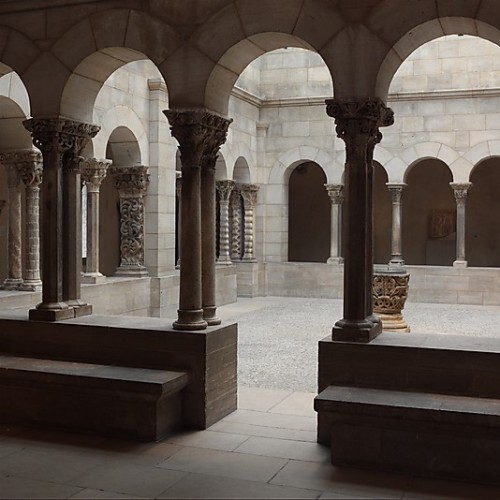#george grey barnard
Cloister from Saint-Guilhem-le-Désert
French
Late 12th c.
Limestone
‘Situated in a valley near Montpellier in southern France, the Benedictine abbey of Saint-Guilhem-le-Désert was founded in 804 by Guilhem (Guillaume) au Court-Nez, duke of Aquitaine and a member of Charlemagne’s court. By the twelfth century, the abbey had been named in honor of its founder and had become an important site on one of the pilgrimage roads that ran through France to the holy shrine of Santiago de Compostela in Spain. With the steady visits of travelers en route to the shrine and the gifts they brought with them, a period of prosperity came to the monastery. By 1206 a new, two-story cloister had been built at Saint-Guilhem, incorporating the columns and pilasters from the upper gallery seen here. Most of these columns are medieval versions of the classical Corinthian column, based on the spiny leaf of the acanthus. This floral ornamentation is treated in a variety of ways. Naturalistic acanthus, with clustered blossoms and precise detailing, is juxtaposed with decoration in low, flat relief, swirling vine forms, and even the conventionalized bark of palm trees. Among the most beautiful capitals are those embellished by drill holes, sometimes in an intricate honeycomb pattern. Like the adaptation of the acanthus-leaf decoration, this prolific use of the drill must have been inspired by the remains of Roman sculpture readily available in southern France at the time. The drilled dark areas contrast with the cream-colored limestone and give the foliage a crisp lacy look that is elegant and sophisticated.
Like other French monasteries, Saint-Guilhem suffered greatly in the religious wars following the Reformation and during the French Revolution, when it was sold to a stonemason. The damages were so severe that there is now no way of determining the original dimensions of the cloister or the number and sequence of its columns. Those collected here served in the nineteenth century as grape-arbor supports and ornaments in the garden of a justice of the peace in nearby Aniane. They were purchased by the American sculptor George Grey Barnard before the First World War and brought to this country. A portion of the original cloister remains at Saint-Guilhem.’
The cloister is in the collection of The Cloisters, The Metropolitan Museum of Art. Description and image taken from the Met’s website. You can see more photos of the cloister here on their site.
(**Tour 4/5)
Post link
Capitals from the Cloister from Saint-Michel-de-Cuxa
Catalan
circa 1130-40
Marble
‘The Benedictine monastery of Saint-Michel-de-Cuxa, located at the foot of Mount Canigou in the northeast Pyrenees, was founded in 878. In 1791, Cuxa’s monks departed in the wake of the French Revolution, and much of the monastery’s stonework was subsequently dispersed. The monastery’s cloister, built during the twelfth century, originally measured some 156 by 128 feet, or approximately twice its current size at The Cloisters, much of whose architecture is modern. Like the ensemble from Saint-Guilhem, elements were purchased by George Grey Barnard and brought to the United States; part of the cloister survives at the monastery which, once again, houses a community of monks.
The cloister was the heart of a monastery. By definition, it consists of a covered walkway surrounding a large open courtyard, with access to all other monastic buildings. Usually attached to the southern flank of the church, a cloister was at the same time passageway and processional walkway, a place for meditation and for reading aloud. At once serene and bustling, the cloister was also the site where the monks washed their clothes and themselves.
The warm beauty of the native pink marble used at Cuxa harmonizes this cloister’s many elements, such as the varied capital sculptures carved during different periods in its construction. Some of these are fashioned in the simplest of block forms, while others are intricately carved with scrolling leaves, pinecones, animals with two bodies and a common head (a special breed for the corners of capitals), lions devouring people or their own forelegs, or a mermaid holding her tail. While many of these motifs may derive from popular fables or depict the struggle between the forces of good and evil, the conveyance of meaning seems to have been less important for the Cuxa artists than the creation of powerful works capturing the energy and tension between the forms depicted.’
Description and image taken from the Met’s website. You can see more photos of the cloister here on their site.
(**Tour 3/5)
Post link



